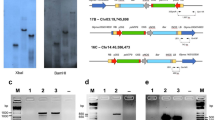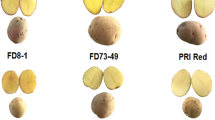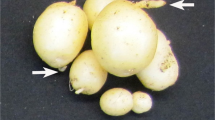Abstract
Potato is a globally important crop. Unfortunately, potato farming is plagued with problems associated with the sprouting behavior of seed tubers. The data presented here demonstrate that using transgenic technology can influence this behavior. Transgenic tubers cytosolically expressing an inorganic pyrophosphatase gene derived from Escherichia coli under the control of the tuber-specific patatin promoter display significantly accelerated sprouting. The period of presprouting dormancy for transgenic tubers planted immediately after harvest is reduced by six to seven weeks when compared to wild-type tubers. This study demonstrates a method with which to regulate dormancy, an important aspect of potato crop management.
This is a preview of subscription content, access via your institution
Access options
Subscribe to this journal
Receive 12 print issues and online access
$209.00 per year
only $17.42 per issue
Buy this article
- Purchase on Springer Link
- Instant access to full article PDF
Prices may be subject to local taxes which are calculated during checkout




Similar content being viewed by others
References
Wiltshire, J.J.J. & Cobb, A.H. A review of the physiology of potato tuber dormancy. Ann. Appl. Biol. 129, 553–569 (1996).
Suttle, J.C. Dormancy in tuberous organs: problems and perspectives. In Plant dormancy, physiology, biochemistry and molecular biology. (ed. Lang, G.A.) 133–143 (Lab International, Oxon, UK; 1996).
Hemberg, T. Potato rest. In Potato physiology. (ed. Li, P.H.) 353–388 (Academic Press, London, UK; 1985).
Turnbull, C.G.N. & Hanke, D.E. The control of bud dormancy in potato Solanum tuberosum cultivar majestic tubers: evidence for the primary role of cytokinins and a seasonal pattern of changing sensitivity to cytokinin. Planta 165, 359–365 (1985).
Suttle, J.C. & Banowetz, G.M. Changes in cis-zeatin and cis-zeatin riboside levels and biological activity during potato tuber dormancy. Phys. Plant. 109, 68–74 (2000).
Suttle, J.C. Postharvest changes in endogenous ABA levels and ABA metabolism in relation to dormancy in potato tubers. Physiol. Plant. 95, 233–240 (1995).
Sorce, C., Lorenzi, R., Ceccarelli, N. & Ranalli, P. Changes in free and conjugated IAA during dormancy and sprouting of potato tubers. Australian J. Plant Phys. 27, 371–377 (2000).
Sorce, C., Piaggesi, A., Ceccarelli, N. & Lorenzi, R. Role and metabolism of abscisic acid in potato tuber dormancy and sprouting. J. Plant Physiol. 149, 548–552 (1996).
Espen, L. et al. Changes in the potato (Solanum tuberosum L.) tuber at the onset of dormancy and during storage at 23 degrees C and 3 degrees C. I. Biochemical and physiological parameters. Potato Res. 42, 189–201 (1999).
ap Rees, T. & Morrell, S. Carbohydrate metabolism in developing potatoes. Am. Potato J. 67, 835–847 (1990).
Kornberg, A. DNA Replication. Trends Biochem. Sci. 9, 122–124 (1984).
Sonnewald, U. Expression of E. coli inorganic pyrophosphatase in transgenic plants alters photoassimilate partitioning. Plant J. 2, 571–581 (1992).
Rocha-Sosa, M. et al. Both developmental and metabolic signals activate the expression of a class I patatin gene. EMBO J. 8, 23–30 (1989).
Jelitto, T., Sonnewald, U., Willmitzer, L., Hajerezai, M. & Stitt, M. Inorganic phosphate content and metabolites in potato and tobacco plants expressing E. coli pyrophosphatase in their cytosol. Planta 188, 238–244 (1992).
Geigenberger, P. et al. Overexpression of pyrophosphatase leads to increased sucrose degradation and starch synthesis, increased activities of enzymes for sucrose–starch interconversions, and increased levels of nucleotides in growing potato tubers. Planta 205, 428–437 (1998).
Preiss, J. Biology and molecular biology of starch synthesis and its regulation. In Oxford surveys of plant cellular and molecular biology, Vol. 7. (ed. Miflin, B.J.) 59–114 (Oxford University Press, Oxford, UK; 1991).
Abel, G.J.W., Springer, F., Willmitzer, L. & Kossmann, J. Cloning and functional analysis of a cDNA encoding a novel 139 kDa starch synthase from potato (Solanum tuberosum L.). Plant J. 10, 981–991 (1996).
Gielen, J. et al. The complete nucleotide sequence of the T-DNA of the Agrobacterium tumefaciens plastid pTi Ach5. EMBO J. 3, 835–846 (1984).
Gallie, D.R., Watts, J.W., Turner, P.C. & Wilson, A. A comparison of eucaryotic viral 5′-leader sequences as enhancers of mRNA expression in vivo. Nucleic Acids Res. 15, 8693–8711 (1987).
Dietze, J., Blau, A. & Willmitzer, L. Agrobacterium-mediated transformation of potato. In Gene transfer to plants. (eds Potrykus, I. & Spangenberg, G.) 24–29 (Springer-Verlag, Berlin; 1995).
Moore, S. & Stein, W.H. Photometric ninhydrin method for use in the chromatography of amino acids. J. Biol. Chem. 176, 367–388 (1948).
Bradford, M.M. A rapid and sensitive method for the quantification of microgram quantities of protein using the principle of protein dye binding. Anal. Biochem. 72, 248–254 (1976).
Stitt, M., Lilley, R.McC., Gerhardt, R. & Heldt, H.W. Metabolite levels in specific cells and subcellular compartments of plant leaves. Methods Enzymol. 174, 518–552 (1989).
Geigenberger, P. & Stitt, M. Sucrose synthase catalyses a readily reversible reaction in vivo in developing potato tubers and other plant tissues. Planta 189, 329–339 (1993).
Gross, P. & ap Rees, T. Alkaline inorganic pyrophosphatase and starch synthesis in amyloplasts. Planta 167, 140–145 (1986).
Zrenner, R., Salnoubat, M., Willmitzer, L. & Sonnewald, U. Evidence of the crucial role of sucrose synthase for sink strength using transgenic potato plants (Solanum tuberosum L.). Plant J. 7, 97–107 (1995).
Zrenner, R., Willmitzer, L. & Sonnewald, U. Analysis of the expression of potato uridinediphosphate–glucose pyrophosphorylase and its inhibition by antisense RNA. Planta 190, 247–252 (1993).
Galloway, C.M. & Mack Dugger, W. Purification and characterization of phosphoglucomutase from peas. Physiol. Plantarum 92, 479–486 (1994).
Burrell, M.M. et al. Genetic manipulation of 6-phosphofructokinase in potato tubers. Planta 194, 95–101 (1994).
Müller-Röber, B., Sonnewald, U. & Willmitzer, L. Antisense inhibition of the ADP glucose pyrophosphorylase in transgenic potato leads to sugar-storing tubers and influences tuber formation and expression of tuber storage protein genes. EMBO J. 11, 1229–1238 (1992).
Acknowledgements
The authors would like to thank Jessyca Dietze for performing the plant transformation, Helga Fleischer-Notter for technical support, and Linda Bartetzko, Britta Hausmann, Kathrin Lepa, Olaf Woiwode, and Bruno Marty for excellent greenhouse work and Dr. U. Sonnewald for the (35S)ppa1 plants. This research was supported by a grant from the Max-Planck Society to E.M.F.
Author information
Authors and Affiliations
Corresponding author
Rights and permissions
About this article
Cite this article
Farré, E., Bachmann, A., Willmitzer, L. et al. Acceleration of potato tuber sprouting by the expression of a bacterial pyrophosphatase. Nat Biotechnol 19, 268–272 (2001). https://doi.org/10.1038/85726
Received:
Accepted:
Issue Date:
DOI: https://doi.org/10.1038/85726
This article is cited by
-
Molecular regulation of potato tuber dormancy and sprouting: a mini-review
Plant Biotechnology Reports (2021)
-
Potato plants with genetically engineered tropane alkaloid precursors
Planta (2017)
-
Control of potato tuber dormancy and sprouting by expression of sense and antisense genes of pyrophosphatase in potato
Acta Physiologiae Plantarum (2016)
-
Regulation of potato tuber sprouting
Planta (2014)
-
Identification of differentially expressed genes in potato associated with tuber dormancy release
Molecular Biology Reports (2012)



